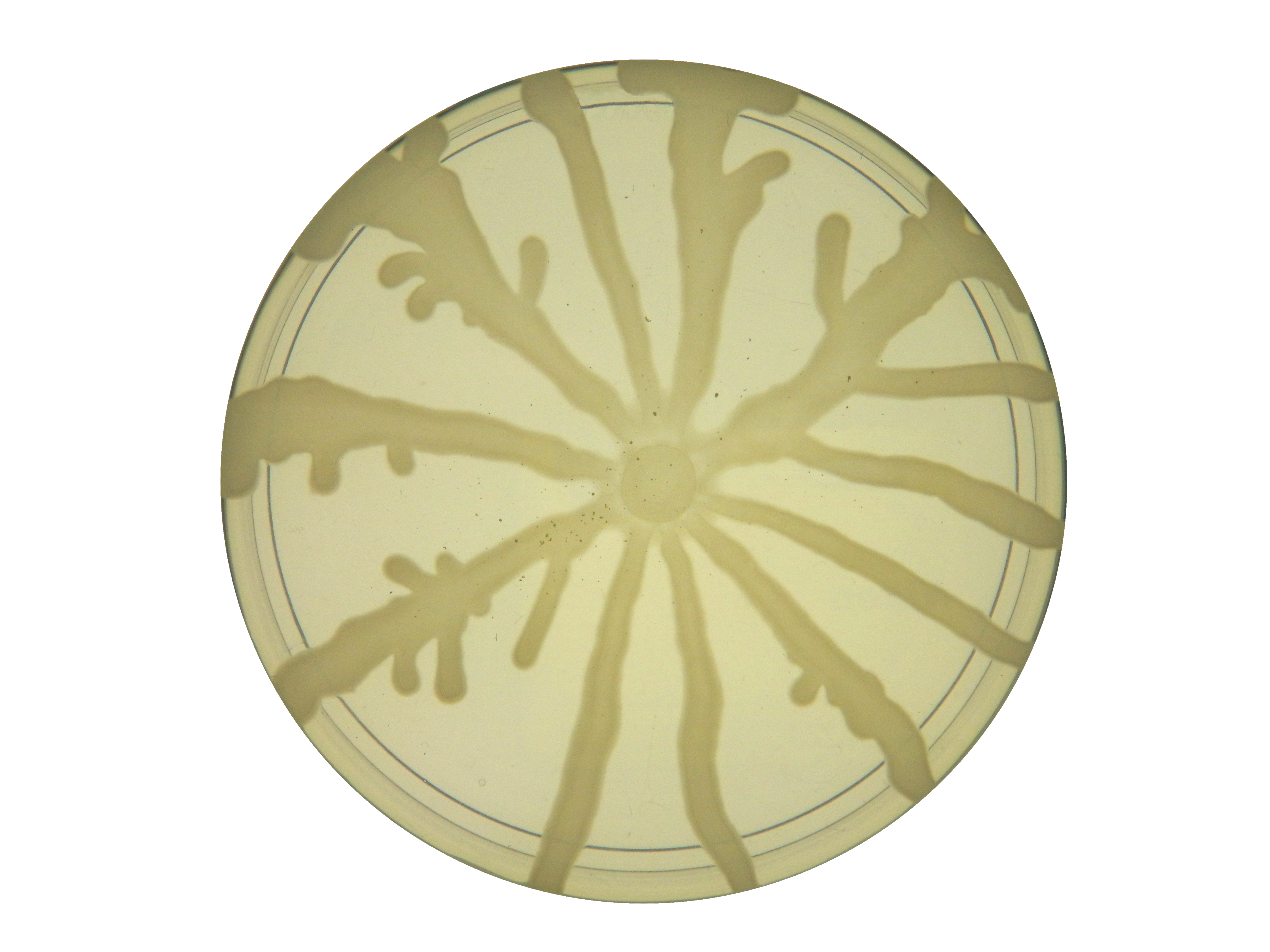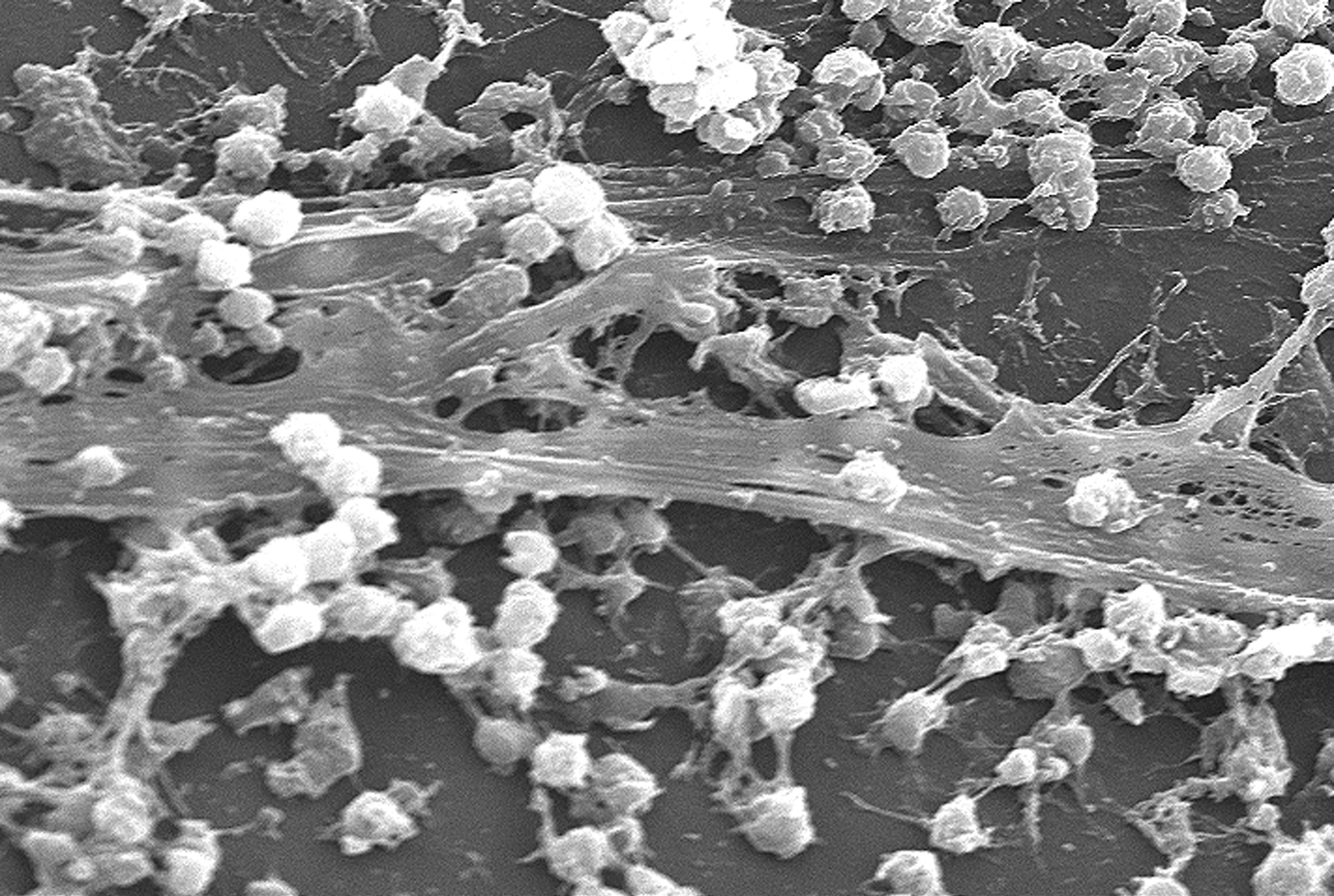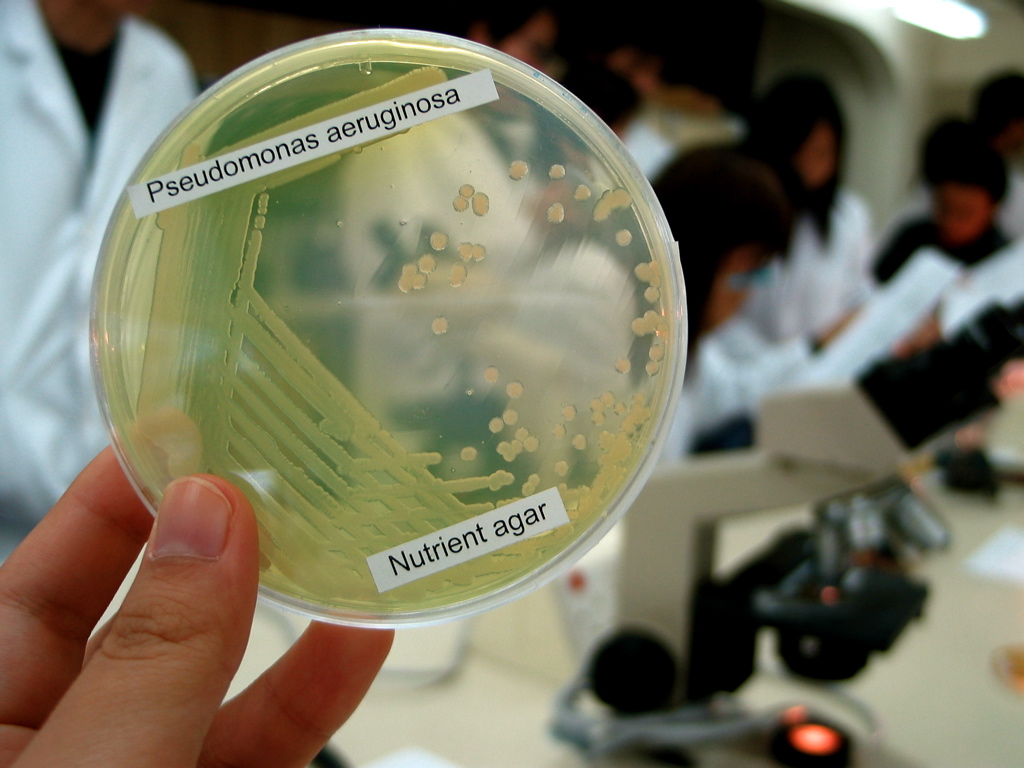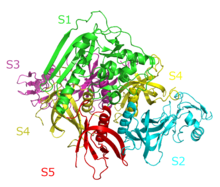|
Rhamnolipid
Rhamnolipids are a class of glycolipid produced by ''Pseudomonas aeruginosa ''Pseudomonas aeruginosa'' is a common Bacterial capsule, encapsulated, Gram-negative bacteria, Gram-negative, Aerobic organism, aerobic–facultative anaerobe, facultatively anaerobic, Bacillus (shape), rod-shaped bacteria, bacterium that can c ...'', amongst other organisms, frequently cited as bacterial surfactants. They have a glycosyl head group, in this case a rhamnose moiety, and a 3-(hydroxyalkanoyloxy)alkanoic acid (HAA) fatty acid tail, such as myrmicacin, 3-hydroxydecanoic acid. Specifically there are two main classes of rhamnolipids: mono-rhamnolipids and di-rhamnolipids, which consist of one or two rhamnose groups respectively. Rhamnolipids are also heterogeneous in the length and degree of branching of the HAA moiety, which varies with the growth media used and the environmental conditions. Rhamnolipids biosynthesis The first genes discovered in a mutagenesis screen for mutants unable to p ... [...More Info...] [...Related Items...] OR: [Wikipedia] [Google] [Baidu] |
Sophorolipids
A sophorolipid is a surface-active glycolipid compound that can be synthesized by a selected number of non-pathogenic yeast species. They are potential bio-surfactants due to their biodegradability and low eco-toxicity. Structure and properties Sophorolipids are glycolipids consisting of a hydrophobic fatty acid tail of 16 or 18 carbon atoms and a hydrophilic carbohydrate head sophorose, a glucose-derived di-saccharide with an unusual β-1,2 bond and can be acetylated on the 6′- and/or 6′′- positions. One terminal or sub terminal hydroxylated fatty acid is β-glycosidically linked to the sophorose module. The carboxylic end of this fatty acid is either free (acidic or open form) or internally esterified at the 4′′ or in some rare cases at the 6′- or 6′′-position (lactonic form). The physicochemical and biological properties of sophorolipids are significantly influenced by the distribution of the lactone vs. acidic forms produced in the fermentative broth. In general, ... [...More Info...] [...Related Items...] OR: [Wikipedia] [Google] [Baidu] |
Rhamnose
Rhamnose (Rha, Rham) is a naturally occurring deoxy sugar. It can be classified as either a methyl- pentose or a 6-deoxy- hexose. Rhamnose predominantly occurs in nature in its L-form as L-rhamnose (6-deoxy-L- mannose). This is unusual, since most of the naturally occurring sugars are in D-form. Exceptions are the methyl pentoses L- fucose and L-rhamnose and the pentose L- arabinose. However, examples of naturally-occurring D-rhamnose are found in some species of bacteria, such as '' Pseudomonas aeruginosa'' and '' Helicobacter pylori''. Rhamnose can be isolated from buckthorn (''Rhamnus''), poison sumac, and plants in the genus ''Uncaria''. Rhamnose is also produced by microalgae belonging to class Bacillariophyceae (diatoms). Rhamnose is commonly bound to other sugars in nature. It is a common glycone component of glycosides from many plants. Rhamnose is also a component of the outer cell membrane of acid-fast bacteria in the ''Mycobacterium'' genus, which includes the ... [...More Info...] [...Related Items...] OR: [Wikipedia] [Google] [Baidu] |
Swarming Motility
Swarming motility is a rapid (2–10 μm/s) and coordinated translocation of a bacterial population across solid or semi-solid surfaces, and is an example of bacterial multicellularity and swarm behaviour. Swarming motility was first reported by Jorgen Henrichsen and has been mostly studied in genus ''Serratia'', ''Salmonella'', ''Aeromonas'', ''Bacillus'', ''Yersinia'', ''Pseudomonas'', ''Proteus (bacterium), Proteus'', ''Vibrio'' and ''Escherichia''. This multicellular behavior has been mostly observed in controlled laboratory conditions and relies on two critical elements: 1) the nutrient composition and 2) viscosity of culture medium (i.e. % agar). One particular feature of this type of motility is the formation of dendritic fractal-like patterns formed by migrating swarms moving away from an initial location. Although the majority of species can produce tendrils when swarming, some species like ''Proteus mirabilis'' do form concentric circles motif instead of dendritic patter ... [...More Info...] [...Related Items...] OR: [Wikipedia] [Google] [Baidu] |
Biofilm
A biofilm is a Syntrophy, syntrophic Microbial consortium, community of microorganisms in which cell (biology), cells cell adhesion, stick to each other and often also to a surface. These adherent cells become embedded within a slimy extracellular matrix that is composed of extracellular polymeric substances (EPSs). The cells within the biofilm produce the EPS components, which are typically a polymeric combination of extracellular polysaccharides, proteins, lipids and DNA. Because they have a three-dimensional structure and represent a community lifestyle for microorganisms, they have been metaphorically described as "cities for microbes". Biofilms may form on living (biotic) or non-living (abiotic) surfaces and can be common in natural, industrial, and hospital settings. They may constitute a microbiome or be a portion of it. The microbial cells growing in a biofilm are physiology, physiologically distinct from planktonic cells of the same organism, which, by contrast, ... [...More Info...] [...Related Items...] OR: [Wikipedia] [Google] [Baidu] |
Pseudomonas Aeruginosa
''Pseudomonas aeruginosa'' is a common Bacterial capsule, encapsulated, Gram-negative bacteria, Gram-negative, Aerobic organism, aerobic–facultative anaerobe, facultatively anaerobic, Bacillus (shape), rod-shaped bacteria, bacterium that can cause disease in plants and animals, including humans. A species of considerable medical importance, ''P. aeruginosa'' is a multiple drug resistance, multidrug resistant pathogen recognized for its ubiquity, its Intrinsic and extrinsic properties, intrinsically advanced antibiotic resistance mechanisms, and its association with serious illnesses – hospital-acquired infections such as ventilator-associated pneumonia and various sepsis syndromes. ''P. aeruginosa'' is able to selectively inhibit various antibiotics from penetrating its outer membrane'' ''– and has high resistance to several antibiotics. According to the World Health Organization ''P. aeruginosa'' poses one of the greatest threats to humans in terms of an ... [...More Info...] [...Related Items...] OR: [Wikipedia] [Google] [Baidu] |
Bordetella
''Bordetella'' () is a genus of small (0.2 – 0.7 μm), Gram-negative, coccobacilli bacteria of the phylum Pseudomonadota. ''Bordetella'' species, with the exception of ''Bordetella petrii, B. petrii'', are obligate aerobes, as well as highly Fastidious organism, fastidious, or difficult to culture. All species can infect humans. The first three species to be described (''Bordetella pertussis, B. pertussis'', ''Bordetella parapertussis, B. parapertussis'', ''Bordetella bronchiseptica, B. bronchiseptica'') are sometimes referred to as the 'classical species'. Two of these (''B. pertussis'' and ''B. bronchiseptica'') are also Motility, motile. There are about 16 different species of ''Bordetella'' likely descending from ancestors who lived in soil and/or water environments. ''B. pertussis'' and occasionally ''B. parapertussis'' cause pertussis (whooping cough) in humans, and some ''B. parapertussis'' strains only colonize sheep. It has also been known to cause bronchitis in c ... [...More Info...] [...Related Items...] OR: [Wikipedia] [Google] [Baidu] |
Surfactants
Surfactants are chemical compounds that decrease the surface tension or interfacial tension between two liquids, a liquid and a gas, or a liquid and a solid. The word ''surfactant'' is a blend of "surface-active agent", coined in 1950. As they consist of a water-repellent and a water-attracting part, they enable water and oil to mix; they can form foam and facilitate the detachment of dirt. Surfactants are among the most widespread and commercially important chemicals. Private households as well as many industries use them in large quantities as detergents and cleaning agents, but also for example as emulsifiers, wetting agents, foaming agents, antistatic additives, or dispersants. Surfactants occur naturally in traditional plant-based detergents, e.g. horse chestnuts or soap nuts; they can also be found in the secretions of some caterpillars. Today one of the most commonly used anionic surfactants, linear alkylbenzene sulfates (LAS), are produced from petroleum ... [...More Info...] [...Related Items...] OR: [Wikipedia] [Google] [Baidu] |
Type IV Pili
A pilus (Latin for 'hair'; : pili) is a hair-like cell-surface appendage found on many bacteria and archaea. The terms ''pilus'' and '' fimbria'' (Latin for 'fringe'; plural: ''fimbriae'') can be used interchangeably, although some researchers reserve the term ''pilus'' for the appendage required for bacterial conjugation. All conjugative pili are primarily composed of pilin – fibrous proteins, which are oligomeric. Dozens of these structures can exist on the bacterial and archaeal surface. Some bacteria, viruses or bacteriophages attach to receptors on pili at the start of their reproductive cycle. Pili are antigenic. They are also fragile and constantly replaced, sometimes with pili of different composition, resulting in altered antigenicity. Specific host responses to old pili structures are not effective on the new structure. Recombination between genes of some (but not all) pili code for variable (V) and constant (C) regions of the pili (similar to immunoglobulin dive ... [...More Info...] [...Related Items...] OR: [Wikipedia] [Google] [Baidu] |
Motility
Motility is the ability of an organism to move independently using metabolism, metabolic energy. This biological concept encompasses movement at various levels, from whole organisms to cells and subcellular components. Motility is observed in animals, microorganisms, and even some plant structures, playing crucial roles in activities such as foraging, reproduction, and cellular functions. It is genetically determined but can be influenced by environmental factors. In multicellular organisms, motility is facilitated by systems like the Nervous system, nervous and Human musculoskeletal system, musculoskeletal systems, while at the cellular level, it involves mechanisms such as amoeboid movement and flagellar propulsion. These cellular movements can be directed by external stimuli, a phenomenon known as taxis. Examples include chemotaxis (movement along chemical gradients) and phototaxis (movement in response to light). Motility also includes physiological processes like gastroi ... [...More Info...] [...Related Items...] OR: [Wikipedia] [Google] [Baidu] |
Phagocytosis
Phagocytosis () is the process by which a cell (biology), cell uses its plasma membrane to engulf a large particle (≥ 0.5 μm), giving rise to an internal compartment called the phagosome. It is one type of endocytosis. A cell that performs phagocytosis is called a phagocyte. In a Multicellular organism, multicellular organism's immune system, phagocytosis is a major mechanism used to remove pathogens and cell debris. The ingested material is then digested in the phagosome. Bacteria, dead tissue cells, and small mineral particles are all examples of objects that may be phagocytized. Some protozoa use phagocytosis as means to obtain nutrients. The two main cells that do this are the Macrophages and the Neutrophils of the immune system. Where phagocytosis is used as a means of feeding and provides the organism part or all of its nourishment, it is called phagotrophy and is distinguished from osmotrophy, which is nutrition taking place by absorption. History The history of phag ... [...More Info...] [...Related Items...] OR: [Wikipedia] [Google] [Baidu] |
Virulence
Virulence is a pathogen's or microorganism's ability to cause damage to a host. In most cases, especially in animal systems, virulence refers to the degree of damage caused by a microbe to its host. The pathogenicity of an organism—its ability to cause disease—is determined by its virulence factors. In the specific context of gene for gene systems, often in plants, virulence refers to a pathogen's ability to infect a resistant host. Virulence can also be transferred using a plasmid. The noun ''virulence'' (Latin noun ) derives from the adjective ''virulent'', meaning disease severity. The word ''virulent'' derives from the Latin word ''virulentus'', meaning "a poisoned wound" or "full of poison". The term ''virulence'' does not only apply to viruses. From an ecological standpoint, virulence is the loss of fitness induced by a parasite upon its host. Virulence can be understood in terms of proximate causes—those specific traits of the pathogen that help make the host ... [...More Info...] [...Related Items...] OR: [Wikipedia] [Google] [Baidu] |
Virulence Factors
Virulence factors (preferably known as pathogenicity factors or effectors in botany) are cellular structures, molecules and regulatory systems that enable microbial pathogens (bacteria, viruses, fungi, and protozoa) to achieve the following: * colonization of a niche in the host (this includes movement towards and attachment to host cells) * immunoevasion, evasion of the host's immune response * immunosuppression, inhibition of the host's immune response (this includes leukocidin-mediated cell death) * entry into and exit out of cells (if the pathogen is an intracellular one) * obtain nutrition from the host Specific pathogens possess a wide array of virulence factors. Some are chromosomally encoded and intrinsic to the bacteria (e.g. capsules and endotoxin), whereas others are obtained from mobile genetic elements like plasmids and bacteriophages (e.g. some exotoxins). Virulence factors encoded on mobile genetic elements spread through horizontal gene transfer, and can convert ... [...More Info...] [...Related Items...] OR: [Wikipedia] [Google] [Baidu] |







